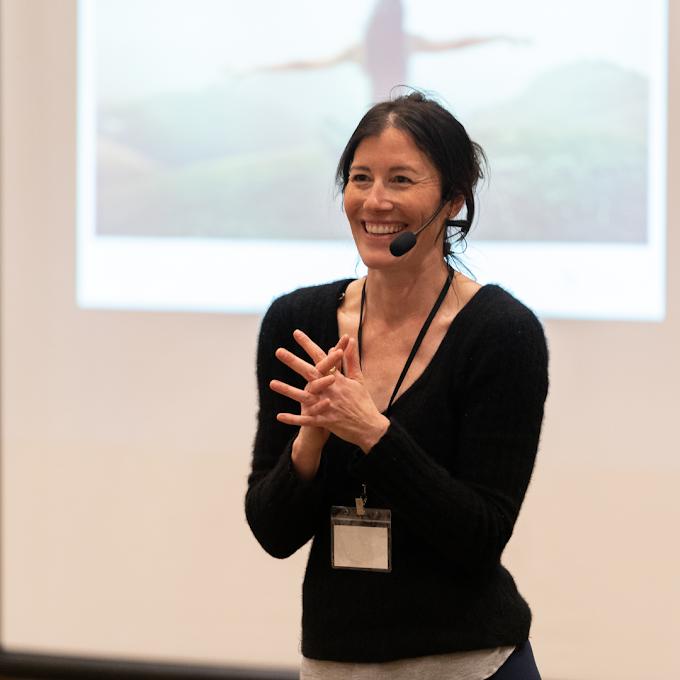Rachel Scott’s 9 Secrets to Becoming a Renowned Online Educator

Rachel Scott is a powerhouse in the world of online yoga education, teaching continuing education courses specifically designed for yoga instructors.
She began her career as a yoga teacher. “I’ve always loved education,” Scott explains. “Becoming a yoga teacher trainer has made me a better yoga teacher, and I’m passionate about working with others who love what they do.”
Soon, she aspired to go deeper into training other teachers—allowing her to further explore the philosophy, history, and mechanics of yoga. This journey took her from New York to Vancouver, where she served as the Director of Teacher’s College at YYoga and oversaw the development of their full suite of teacher certification programs. At this time, online yoga courses were gaining in popularity—but the ones she took just weren’t cutting it. “I thought, there’s gotta be a better way to help these amazing yoga teachers translate what they’re doing into the online space.”
With the drive to bridge this gap, she earned a master’s degree in instructional systems and learning technology, equipping herself with the skills to guide other yoga educators in building clear, structured, and thoughtful online programs that are as engaging and structured as in-person classes.
Now, after years of teaching and building courses under her own brand, Rachel Scott Yoga, she’s helped hundreds of yoga instructors elevate their practice. Plus, she’s been able to take her online business on the road, touring Canada and the US for the past year on an incredible adventure with her partner.

Here are Scott’s top tips for anyone looking to create impactful online courses:
Skip ahead:
- Start with the end result in mind
- Develop clear learning objectives
- Show up for your students—live
- Keep your content short and focused
- Don’t underestimate the power of learning assessments
- Simplify your marketing
- Embrace slow, organic growth
- Start with service in mind
- Set fair prices
Start with the end result in mind
Creating a successful online course isn’t magic; it starts with creating clear goals.
She suggests starting with thinking about where you want people to end up. ”What do you want them to learn, feel, and take away?” she shares. “Reverse engineer the process, starting with where your learners currently are and how you can fill the gap.”
For Scott, this approach is the key to structuring any successful online course, as it helps her build each program with a clear, organized path from beginning to end. Now, she’s able to create courses relatively quickly, as she has a streamlined system for how she goes from idea to final product.
Her popular sequencing mentorship program exemplifies this approach. Plus, with Thinkific’s Bundle feature, Scott groups related courses into larger offerings such as her 300 hour advanced yoga training, providing a comprehensive learning experience.
Develop clear learning objectives
According to Scott, learning objectives are often misunderstood; most creators are too ambiguous when setting them. The key is to make them specific, measurable, and actionable, as laser-focused objectives help create a roadmap for both students and course creators.
She warns creators to avoid creating content before they’ve determined their learning objectives. This keeps the content creation process smooth. “It can feel tedious and time-consuming to create really good learning objectives, but once you do, the course writes itself,” she says.
“The biggest mistake that folks make is that they get super excited about what they’re going to create, and they want to just start creating it,” continues Scott. “Creators often start creating videos and other material right away, when that should be the last step.”
Show up for your students—live
Through her own trial and error process, Scott believes that the best online courses are those that use a mix of synchronous and asynchronous content. “It’s important for faculty to show up and to hold the space for students, while also having pre-recorded material to support the live component,” she says. “To me, that’s a great way to leverage what we can do in Thinkific while also having those in-person touch points, which are so important.”
“I can run many programs at once because I leverage Thinkific for so much of the asynchronous content,” she continues excitedly.
According to Scott, live interactions give students the chance to ask questions and connect on a deeper level, while pre-recorded materials allow them to progress at their own pace. She encourages trainers to consider offering scheduled meeting times so you can build rapport and provide that vital in-person connection.

Keep your content short and focused
Many creators make the mistake of either making their content way too long, or trying to cram in too much information—resulting in less intentional, concise videos.
Scott advises creators to aim for short, focused videos, ideally around six minutes. This length allows learners to logistically be able to complete each video and gain the feeling of accomplishment once they’ve completed each one. “It’s so easy to give too much information and overload your students,” she shares. “Keep in mind that there are at-home learners, and they need to fit the learning into their lives. If they get too overwhelmed by the amount of material, they’ll check out.”
Her formula for structuring each video includes presenting a key idea, applying it, and then offering a reflection through a tool like a quiz, available on Thinkific.
For editing, Scott uses Camtasia and focuses on clear audio, good lighting, and a welcoming presence. While it can be intimidating being on camera, she reassures creators to be unscripted—and authentically themselves. “Do your prep, put yourself in front of the camera, and give yourself permission to be extemporaneous,” she continues. “Remember: done is better than perfect.”
Don’t underestimate the power of learning assessments
Scott stresses that just because you provide your students with a bunch of information, it doesn’t mean they’re able to retain it all.
Since online learning often lacks the visual cues of in-person teaching, learning assessments become crucial. “One of the challenges with online learning is that you don’t always see your students’ faces to know if they’re engaged and understanding,” she shares.
She suggests that creators strategically use check-in points. “With Thinkific, you can create automated quizzes to help reinforce key bits of knowledge.”
The level of assessment complexity should match the course’s purpose. “Is this a certification, or are they learning for personal enrichment? The type of assessment will vary accordingly,” Scott explains.
Simplify your marketing
Scott believes that high-quality courses are their own best marketing tools—meaning that if you create a great course, people will talk about it.
Her marketing strategy involves running courses with start and end dates, which creates urgency and gives learners a sense of structure. “When there’s a time limit, people are more likely to enroll,” she explains. “A start date also helps give them an opportunity to prioritize something they want.”
Scott uses social media platforms like Instagram, Facebook, and YouTube to share her work but encourages creators to keep it simple. “Let’s not underestimate the old style of telling people about your offering via word of mouth,” she shares.
“Go to where your people are and leverage your current network,” she adds.
Embrace slow, organic growth
While it’s great to dream about the potential success of your first evergreen course, Scott encourages creators to have a grounded approach.
“Many people think that they can create their first online evergreen course and make millions,” she says. “The reality is, your success isn’t going to happen in a day. Give yourself a little room to make mistakes.”
Scott encourages creators to let go of the pressure to find their niche right away. She believes that it’s better to let yourself find your niche over time—sometimes, years. She encourages creators to let go of rushing and instead focus on providing value to their community, allowing their niche to emerge as they get to know their students and their needs.
“It’s about slow, incremental growth—you don’t have to compete with everybody,” she says.
Start with service in mind
For those just starting out, Scott recommends they focus on the question: How can I be of service?
“Think about who you’re trying to be of service to, and how you can do that,” she says. “When you start from that place, your offerings become more clear.”
Staying connected to her community is the secret behind her course ideas. Serving people simplifies everything, according to Scott, and It helps creators cut through the noise.
Set fair prices
Pricing is often a challenge for new creators, who might be tempted to overprice their first course. Scott encourages creators to remember that they likely won’t earn back all the time they’ve invested right away—it often takes multiple runs of the same course to earn what they’ve put in.
For Scott, once she creates the course, she determines how much time she will show up live. Then, she determines what her hourly rate is, adds it together, and charges that price.
Looking ahead, Scott is excited for the future, sharing that there are always more courses to create. Her journey shows that creating a thriving online education business takes dedication, patience, and a service-minded approach.
Ready to take the first step? Start your free Thinkific trial today.
See related Case Studies
-

How American Paint Horse Association Brought Equine Education to the World—and Grew Revenue by 486%
Read more: How American Paint Horse Association Brought Equine Education to the World—and Grew Revenue by 486%Since moving their programs online, American Paint Horse Association has achieved 486% revenue growth, streamlined operations, and expanded its global reach.
-

How Admirato Made Faith-Driven Learning Accessible Globally
Read more: How Admirato Made Faith-Driven Learning Accessible GloballyHow a US-based digital learning company makes high-quality theological education accessible for individuals and groups all around the world.
-

8 Ways Jelly Academy Became a Leader in Digital Marketing Training
Read more: 8 Ways Jelly Academy Became a Leader in Digital Marketing TrainingLearn 8 way that Jelly Academy became a leader in digital marketing training.
